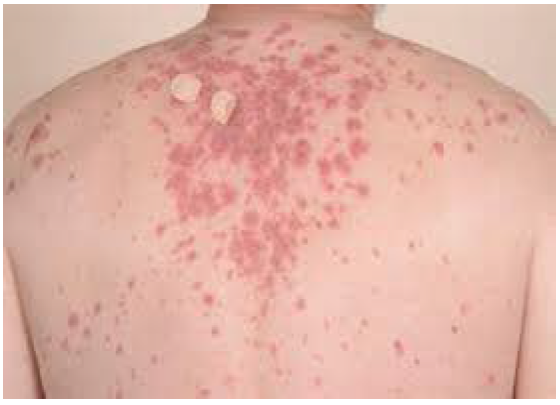Image Article - (2022) Volume 9, Issue 9
Received: 01-Sep-2022, Manuscript No. JPD-23-86049;
Editor assigned: 03-Sep-2022, Pre QC No. P-86049;
Reviewed: 17-Sep-2022, QC No. Q-86049;
Revised: 23-Sep-2022, Manuscript No. R-86049;
Published:
30-Sep-2022
, DOI: 10.37421/2684-4281.2022.9.365
Citation: Hinescu, Mihaela. “Manifestation, Effects and Medicaments of Pemphigus.” J Dermatol Dis 9 (2022): 365
Copyright: © 2022 Hinescu M. This is an open-access article distributed under the terms of the Creative Commons Attribution License, which permits unrestricted use, distribution, and reproduction in any medium, provided the original author and source are credited.

Pemphigus is an autoimmune disease that causes blistering of the skin as well as the insides of the mouth, nose, throat, eyes, and genitals. In the United States, the disease is uncommon. Pemphigus is an autoimmune disease in which the immune system incorrectly attacks cells in the skin's top layer (epidermis) and mucous membranes. Patients with the disease produce antibodies against desmogleins, which are proteins that bind skin cells together. When these bonds are broken, the skin becomes fragile, and fluid can accumulate between its layers, resulting in blisters. Pemphigus is classified into two types, the most common of which are Pemphigus vulgaris is a skin and mucous membrane disease that typically affects the inside of the mouth. Pemphigus foliaceus is a skin condition. There is no cure for pemphigus, but it is often manageable with medications.
Pemphigus is an autoimmune disorder in which the immune system attacks normal skin. Antibodies, which are immune molecules, target proteins called desmogleins, which help connect neighbouring skin cells. When these connections are broken, the skin becomes fragile, and fluid can accumulate between cell layers, resulting in blisters. The immune system normally protects the body from infection and disease. Researchers are unsure what causes the immune system to activate the body's own proteins, but they believe genetic and environmental factors are both involved. Something in the environment may cause pemphigus in people who are predisposed to it due to their genetic makeup. Pemphigus can be caused by a tumour or by certain medications in rare cases.
Blistering of the skin and, in some cases, mucosal surfaces such as the inside of the mouth, nose, throat, eyes, and genitals is the primary symptom of pemphigus. The blisters are weak and prone to bursting, resulting in crusty sores. Blisters on the skin may fuse, resulting in raw-looking areas that are prone to infection and ooze copious amounts of fluid. The symptoms differ slightly depending on the type of pemphigus. Pemphigus vulgaris blisters frequently begin in the mouth, but they can later develop on the skin. The skin may become so fragile that rubbing it with a finger causes it to peel off. Mucosal surfaces such as the nose, throat, eyes, and genitals may be affected as well. Blisters are painful and form within the deep layer of the epidermis. Pemphigus foliaceus affects only the skin. Blisters most commonly appear on the face, scalp, chest, or upper back, but they can spread to other areas of skin on the body. Skin in the affected area may become inflamed and peel off in layers or scales. Blisters form in the upper layers of the epidermis and can be itchy or painful [1-3].
Google Scholar, Crossref, Indexed at
Google Scholar, Crossref, Indexed at
Journal of Dermatology and Dermatologic Diseases received 4 citations as per Google Scholar report